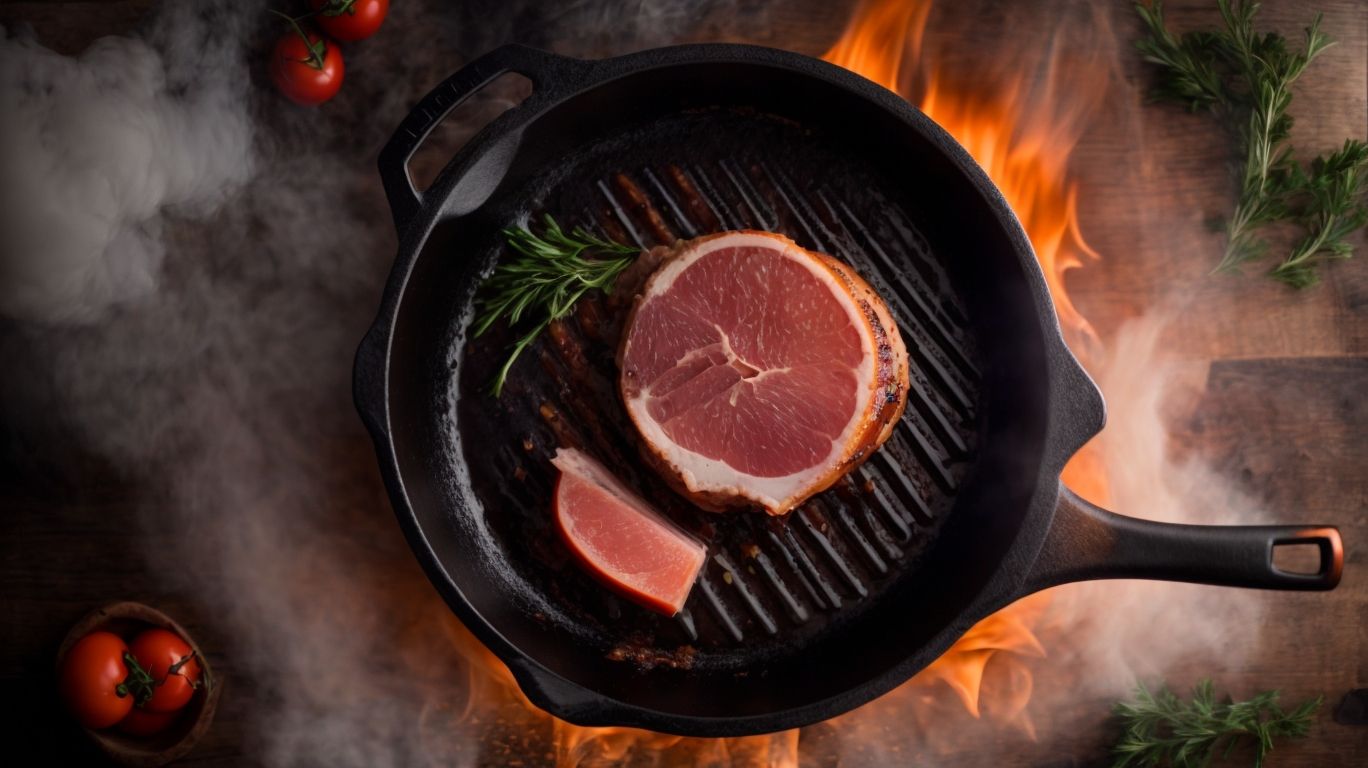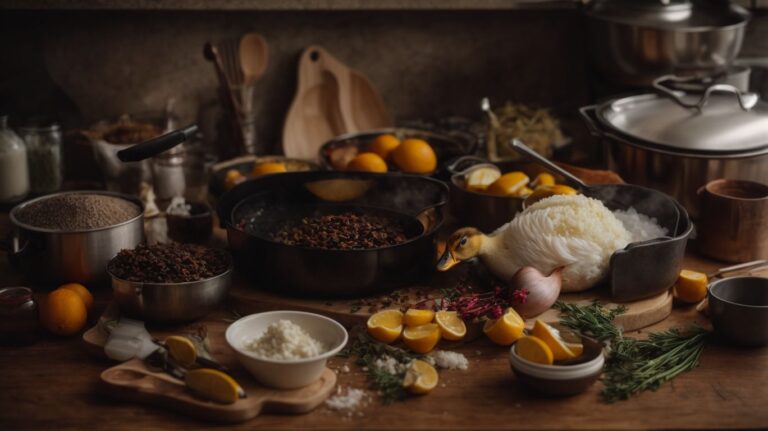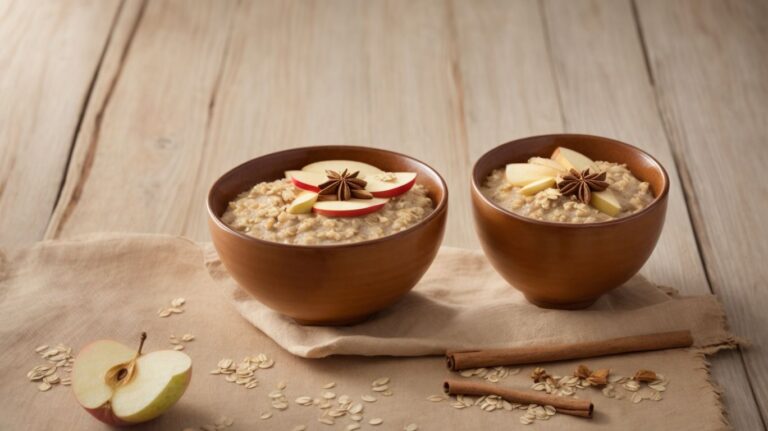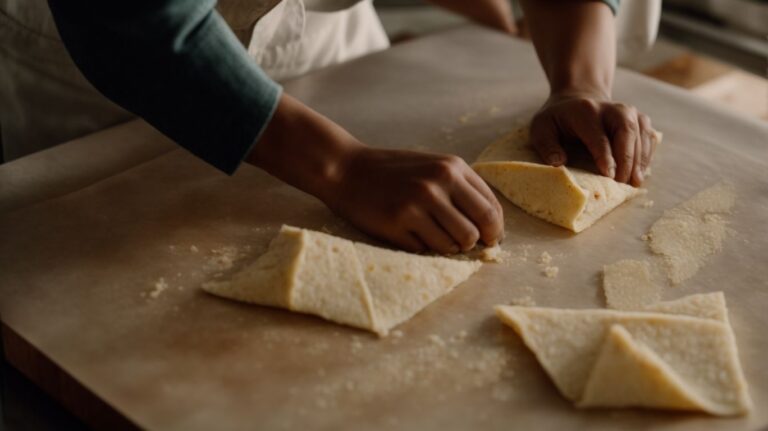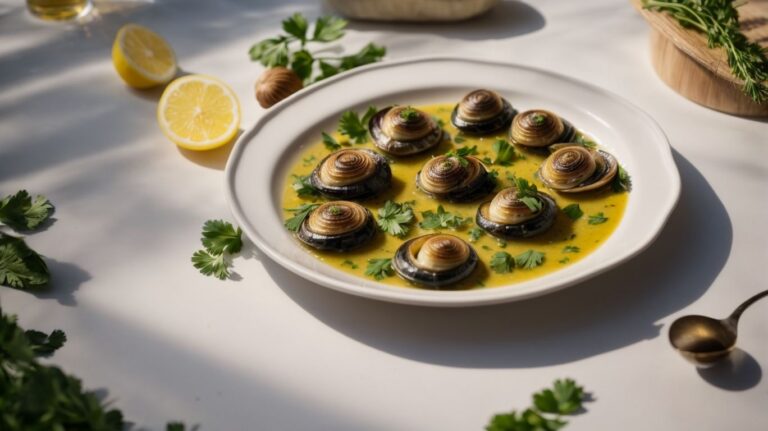How to Cook Ham Steak?
Looking to elevate your cooking game with a delicious and versatile ingredient? Consider ham steak!
We will explore everything you need to know about this flavorful cut of meat – from the difference between ham steak and regular ham, to tips for buying the perfect cut, and methods for cooking it to perfection.
Get ready to impress your taste buds and your dinner guests with the ultimate guide to cooking the perfect ham steak.
Key Takeaways:
What is Ham Steak?
Ham steak is a delicious dish made from a thick slice of fully cooked pork, often glazed with a mixture of butter, maple syrup, brown sugar, garlic powder, and other spices.
When preparing a succulent ham steak, it’s crucial to select a quality cut with a good balance of meat and fat to ensure juiciness and flavor. Ham steaks offer a rich, savory taste with a hint of sweetness from the glaze. The glazing process involves gently brushing the mixture over the steak, allowing it to caramelize and enhance the flavors. Cooking methods such as grilling, pan-searing, or baking can be used to achieve a deliciously charred exterior while keeping the meat tender and juicy.
What is the Difference Between Ham Steak and Regular Ham?
The key difference between ham steak and regular ham lies in the cut and thickness; while regular ham is typically sliced thinly and used in sandwiches or salads, ham steak is a thick slice that can be a standalone dish or part of a hearty meal.
Ham steak offers a heartier, meatier texture compared to its thinly sliced counterpart, providing a satisfying chewiness that stands out in casseroles, soups, and stews. This texture also makes it ideal for grilling, pan-searing, or baking, allowing it to hold its shape and absorb flavors beautifully. The rich, savory flavor of ham steak adds depth to dishes like scalloped potatoes, quiches, or pasta bakes, making it a versatile ingredient for both breakfast and dinner recipes.
What to Look for When Buying Ham Steak?
When purchasing ham steak, consider the type of ham, the specific cut you prefer, and the size of the steak to ensure it aligns with your recipe and serving needs.
Regarding the type of ham, popular options include smoked, honey glazed, and black forest ham, each offering a distinct flavor profile. It’s essential to choose a ham variety that complements your dish, whether you prefer a richer, smokier taste or a sweeter glaze.
Thickness is another vital factor – thicker slices tend to be juicier and may take longer to cook, while thinner slices cook faster and can be ideal for certain recipes such as quick skillet meals.
Consider the portion sizes you require based on the number of servings needed and whether you plan to use the ham steak as a main course or as part of a larger meal.
Thawing the Ham
Thawing the ham steak properly is crucial to ensure even cooking and optimal flavor absorption throughout the meat.
To thaw a ham steak safely, consider transferring it from the freezer to the refrigerator and allowing it to thaw slowly over a day or two. This gradual thawing process helps maintain the meat’s quality and reduces the risk of bacterial growth.
If you’re pressed for time, you can also place the ham steak in a leak-proof plastic bag and submerge it in cold water, changing the water every 30 minutes. Avoid using hot water or leaving the ham steak out at room temperature, as this can lead to uneven thawing and potential foodborne illnesses.
Seasoning the Ham
Seasoning the ham steak with a blend of spices like garlic powder, dried thyme, and cayenne pepper can elevate its flavor profile and create a savory experience.
Exploring flavor combinations further, consider adding a touch of brown sugar and a hint of smoked paprika to the spice mix for a sweet and smoky undertone that complements the richness of the ham.
Regarding marinating techniques, allowing the ham steak to sit in the spice mixture for at least an hour, or even overnight, can intensify the flavors and ensure a deeply seasoned taste throughout the meat.
For a more zesty twist, experiment with citrus zest, such as lemon or orange, along with a pinch of fresh herbs like parsley or rosemary to brighten up the dish and add a refreshing element to the ham steak.
Methods for Cooking Ham Steak

Credits: Poormet.Com – Christopher Jackson
Cooking ham steak can be done through different methods such as grilling, pan-frying, or baking, each offering unique textures and flavors to the dish.
Regarding grilling, the direct exposure to open flame or heat source imparts a smoky flavor while caramelizing the outer layer for a delicious crust.
For those who prefer a quicker method, pan-frying is ideal, allowing for a crispy exterior while maintaining a juicy interior.
On the other hand, baking ensures even cooking throughout, resulting in a tender ham steak with well-developed flavors throughout.
These methods not only affect the taste but also play a crucial role in the visual appeal of the final dish, influencing how it is presented and enjoyed.
Grilling
Grilling ham steak over an open flame or on a grill pan can impart a smoky flavor and beautiful grill marks, enhancing its overall taste and visual appeal.
When grilling ham steak, it’s crucial to prep your grill properly to ensure even cooking. Preheat your grill to around 375°F (190°C) for optimal results. For a charcoal grill, wait until the coals are covered with a white ash before placing the steak on the grate. Once the grill is hot, season your ham steak with your favorite spices or marinade to add depth of flavor. Keep a meat thermometer handy to cook the steak to an internal temperature of 145°F (63°C) for safe consumption.
Pan-frying
Pan-frying ham steak in a skillet with butter or olive oil is a quick and easy method that yields a crispy exterior and juicy interior, perfect for a delicious meal.
To begin, start by heating a skillet over medium heat and adding a teaspoon of olive oil or a pat of butter. Once the skillet is hot, carefully place the ham steak in the skillet. Sear it for about 3-4 minutes on each side, until a golden-brown crust forms. Adjust the heat as needed to prevent burning while ensuring a thorough cook. For added flavor, you may sprinkle some herbs or spices over the steak as it cooks. Once done, remove the ham steak from the skillet and let it rest for a few minutes before serving to lock in the juices.
Baking
Baking ham steak in the oven with a sweet glaze of maple syrup and brown sugar can caramelize the exterior, locking in moisture and creating a delightful balance of flavors.
For a perfect glazed ham steak, preheat your oven to 350°F (175°C). While the oven is heating up, prepare your glaze by combining maple syrup, brown sugar, Dijon mustard, and a dash of apple cider vinegar in a saucepan over low heat. Let the glaze simmer until it thickens slightly, stirring occasionally to prevent burning.
Next, place the ham steak on a foil-lined baking sheet and brush a generous amount of the glaze over the top. This step not only enhances the flavor but also helps in caramelizing the surface during baking.
Temperature and Cooking Time
Achieving the perfect ham steak involves precision in temperature control, cooking time management, and the art of adding complementary flavors to enhance the overall taste.
When cooking ham steak, ensuring that the internal temperature reaches 140°F is critical for both safety and optimal taste. To retain juiciness and tenderness, avoid overcooking by following recommended cooking durations. For added flavor, consider marinating the ham steak with a blend of herbs, spices, and a touch of sweet honey before grilling or pan-searing. Garnishing with fresh herbs like thyme or rosemary can provide a fragrant finish to your dish, elevating the visual appeal as well. Remember, presentation plays a significant role in the overall dining experience, so don’t underestimate the power of a well-plated ham steak.
Adding Flavors
Enhancing the flavors of ham steak with a touch of honey, spices like oregano and onion powder, can elevate its taste profile and create a memorable dining experience.
Experimenting with different spice combinations and sweet elements is a fun way to add depth and complexity to the traditional ham steak. For spice lovers, a mix of cayenne pepper and smoked paprika can bring a subtle heat that harmonizes with the sweetness of the meat. Alternatively, balancing the sweetness of the honey with a hint of tangy mustard or balsamic vinegar can create a delightful contrast of flavors.
Regarding infusion methods, marinating the ham steak in a mixture of apple juice, soy sauce, and garlic before cooking can infuse rich flavors into the meat, enhancing its juiciness and aroma. Another technique involves brining the ham steak in a solution of salt, brown sugar, and aromatic herbs to impart a savory complexity that complements the natural sweetness of the meat.
Consider mixing and matching these flavor enhancement techniques to create a personalized culinary experience that tantalizes the taste buds and delights the senses.
Resting the Ham
Allowing the ham steak to rest before serving ensures that the juices redistribute evenly, enhancing the overall succulence and tenderness of the meat.
Depending on the thickness of the ham steak, it is recommended to let it rest for approximately 5-10 minutes after cooking. This short resting period allows the meat fibers to relax, preventing the juices from seeping out when sliced. Proper rest also enables the flavors to meld together, creating a more harmonious taste profile.
Resting the ham steak not only improves its texture but also makes it easier to slice without losing the flavorful juices. This brief waiting period can make a significant difference in the dining experience, ensuring that each bite is as delicious as possible.
Serving Suggestions for Ham Steak
Ham steak pairs well with a variety of side dishes such as green beans, salads, and eggs, while sauces and glazes can further enhance its flavor profile.
To elevate your ham steak experience, consider serving it with roasted sweet potatoes for a delicious contrast of flavors and textures. Another great side dish option is creamy mashed potatoes, which complement the savory notes of the ham perfectly. For a lighter choice, opt for steamed asparagus drizzled with a lemon butter sauce to add a refreshing touch. Regarding sauces, a classic honey mustard glaze is a popular choice, adding a balance of sweet and tangy flavors. For a more gourmet twist, try a fig and balsamic reduction to elevate the richness of the ham.
Side Dishes
Complementing ham steak with flavorful side dishes like sauteed green beans, fresh salads, or a side of scrambled eggs can create a balanced and satisfying meal.
For those looking to add a touch of freshness to their meal, a vibrant green bean salad tossed with cherry tomatoes, feta cheese, and a balsamic vinaigrette can bring a burst of flavors and colors to the plate. Alternatively, consider serving roasted green beans with a sprinkle of parmesan cheese for a savory and crunchy side dish accompaniment.
Salad variations can offer a delightful range of options, such as a classic Caesar salad with crisp romaine lettuce, homemade croutons, and a creamy dressing, or a light and refreshing mixed green salad with a zesty lemon vinaigrette.
Regarding egg preparations, deviled eggs with a hint of paprika or a fluffy omelet filled with sautéed vegetables can provide a satisfying protein-rich addition to the meal, enhancing the overall taste experience.
Sauces and Glazes
Drizzling honey or maple syrup-based glazes over ham steak can add a delightful sweetness that balances the savory notes, creating a harmonious flavor contrast.
Regarding choosing between honey and maple syrup glazes, both options offer unique flavor profiles that can elevate the taste of your ham steak.
For a classic and rich sweetness, honey is the go-to choice, offering a floral and decadent note that complements the saltiness of the ham. On the other hand, maple syrup brings a deep, caramelized flavor with hints of woodiness, adding a luxurious touch to the dish.
To enhance the flavors further, consider incorporating complementary ingredients like Dijon mustard or balsamic vinegar into your glaze. These additions can introduce a tangy or acidic element that cuts through the sweetness, creating a well-rounded and complex flavor profile.
When applying the glaze, consider using a brush to evenly coat the ham steak, ensuring that every bite is infused with the delicious flavors. Whether you prefer a glossy finish or a caramelized crust, the technique of glazing plays a crucial role in the final presentation and taste of the dish.
By experimenting with different combinations of ingredients and techniques, you can unleash your culinary creativity and customize the perfect sauce or glaze for your ham steak, impressing your guests with a symphony of flavors.
Tips for Cooking the Perfect Ham Steak
Achieving the perfect ham steak involves precision in temperature control, cooking time management, and the art of adding complementary flavors to enhance the overall taste.
Regarding temperature, aim to cook your ham steak at around 145°F to 160°F for that ideal balance of tenderness and juiciness. To determine doneness, use a meat thermometer and insert it into the thickest part of the steak, ensuring accurate readings.
Cooking duration varies depending on the thickness of the steak, but as a general guide, a one-inch thick cut will take about 4-5 minutes per side. For a flavor boost, consider marinating the steak in a mix of herbs, garlic, and citrus juices before grilling or searing to impart a zesty tang.
Temperature and Cooking Time
Monitoring the temperature and cooking time when preparing ham steak is essential to ensure a juicy, tender outcome without compromising flavor or texture.
For a perfectly cooked ham steak, it is recommended to use a meat thermometer to accurately gauge the internal temperature. This precision is crucial in preventing undercooking, which can result in a tough texture, or overcooking, leading to dryness.
Reaching an internal temperature of 145°F (63°C) is ideal for ham steak to be safe to eat while maintaining its juiciness. If you prefer a more well-done consistency, you can cook it to 160°F (71°C). Remember to let the ham steak rest for a few minutes before slicing to retain its juices and flavors.
Adding Flavors
Enhancing the flavors of ham steak with a touch of honey, spices like oregano and onion powder, can elevate its taste profile and create a memorable dining experience.
Regarding flavor enhancement, the options are truly endless. Experimenting with different spice combinations such as cumin, paprika, or even a hint of cinnamon can add depth to the savory notes of the ham steak.
Sweet elements like maple syrup or brown sugar can complement the natural saltiness of the meat, offering a delightful contrast that pleases the palate.
Infusing flavors by marinating the ham steak before cooking or using a brine with herbs like rosemary and thyme can further intensify its taste. Remember, the key lies in balancing these elements to create a harmonious blend that tantalizes your taste buds.
Resting the Ham
Allowing the ham steak to rest before serving ensures that the juices redistribute evenly, enhancing the overall succulence and tenderness of the meat.
Resting times for ham steak typically range from 5 to 10 minutes. During this period, the residual heat continues to cook the meat gently, ensuring a perfect doneness and flavor balance.
In terms of meal presentation, allowing the ham steak to rest gives you the opportunity to plate it elegantly without any hurried carving, resulting in visually appealing dishes that are as pleasing to the eyes as they are to the palate.
For storage, once cooked, let the ham steak cool to room temperature before refrigerating it in an airtight container. Properly stored, the rested ham steak can be enjoyed as leftovers in various dishes without compromising on taste or texture.
Conclusion: Enjoy Your Delicious Ham Steak!
Savor the delightful flavors of ham steak in a quick dinner setting, and explore various serving suggestions to elevate your dining experience.
Whether paired with seasonal vegetables or served with a side of garlic mashed potatoes, the versatility of ham steak makes it a delectable choice for a satisfying meal. The rich, savory aroma that fills the kitchen as it cooks creates an enticing invitation to the dining table. Be it a busy weeknight or a laid-back weekend, the simplicity of preparing a succulent ham steak allows you to focus your energy on adding personal touches to the dish, enhancing both the visual appeal and flavor profile.
Final Thoughts and Recommendations
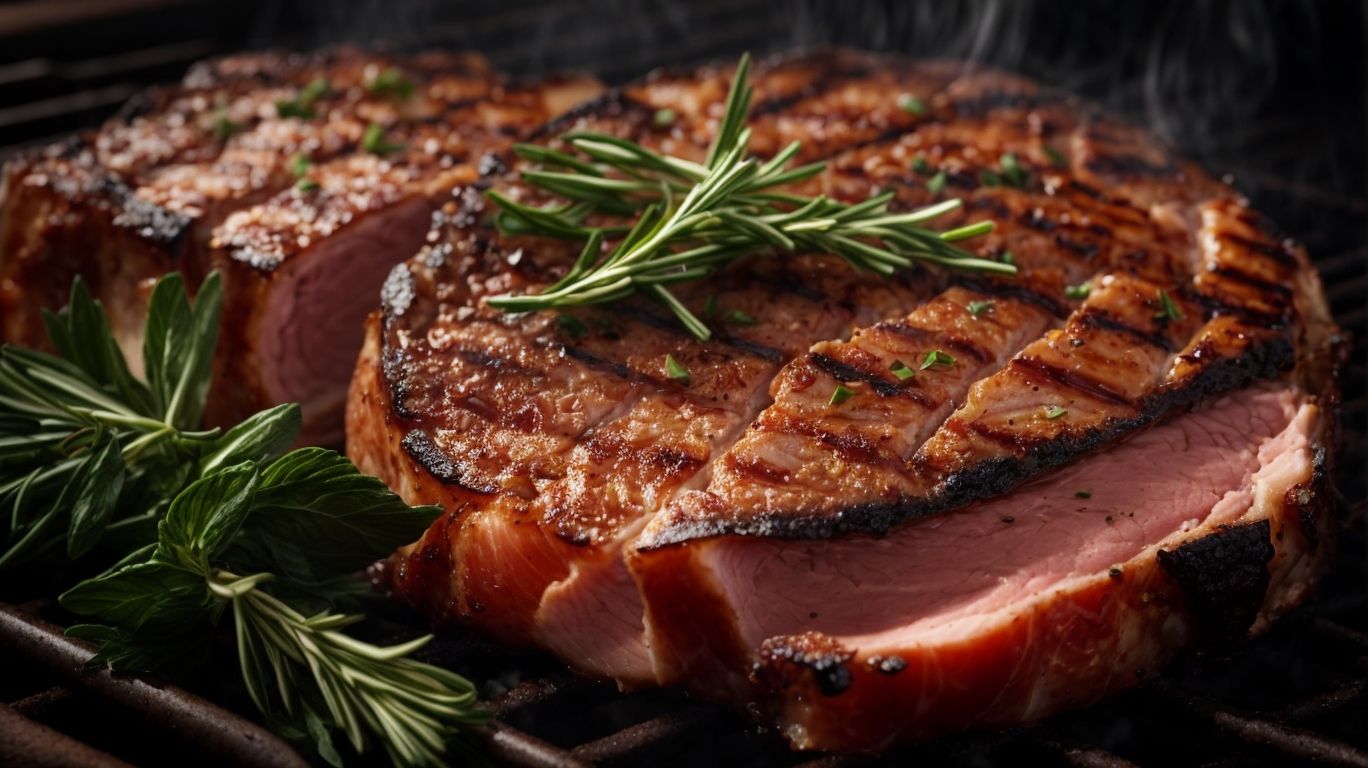
Credits: Poormet.Com – Kyle Green
As the curtain falls on this discussion, it is evident that ham steak’s dynamic flavors, diverse serving options, and culinary allure make it a compelling choice for both seasoned chefs and newcomers alike.
Whether glazed with a maple-bourbon marinade and grilled to caramelized perfection or glazed with a tangy pineapple sauce and broiled to savory succulence, the versatility of ham steak shines through in its ability to adapt to various cooking methods.
For those seeking a quick yet satisfying meal, pan-searing a ham steak and serving it alongside a medley of roasted vegetables can create a feast for both the eyes and the taste buds.
The rich umami notes of the meat combined with the subtle sweetness of the glaze create a harmonious symphony of flavors on the palate.
Frequently Asked Questions
How to Cook Ham Steak?
Question: What is the best way to cook ham steak?
The best way to cook ham steak is by grilling or pan-frying it for a crispy exterior and juicy interior.
How to Cook Ham Steak?
Question: Can I bake ham steak?
Yes, you can bake ham steak in the oven by placing it on a baking sheet and cooking it at 375 degrees Fahrenheit for 15-20 minutes.
How to Cook Ham Steak?
Question: How do I know when ham steak is fully cooked?
Ham steak is fully cooked when it reaches an internal temperature of 145 degrees Fahrenheit. Use a meat thermometer to check the temperature.
How to Cook Ham Steak?
Question: Do I need to marinate ham steak before cooking?
You can marinate ham steak before cooking for added flavor, but it is not necessary. The meat is already cured and seasoned.
How to Cook Ham Steak?
Question: Can I freeze leftover cooked ham steak?
Yes, you can freeze leftover cooked ham steak. Let it cool completely before storing it in an airtight container or freezer bag.
How to Cook Ham Steak?
Question: Are there any vegetarian alternatives for ham steak?
Yes, there are vegetarian alternatives for ham steak, such as plant-based ham substitutes made from tofu or tempeh. These can be cooked in a similar way to traditional ham steak.

